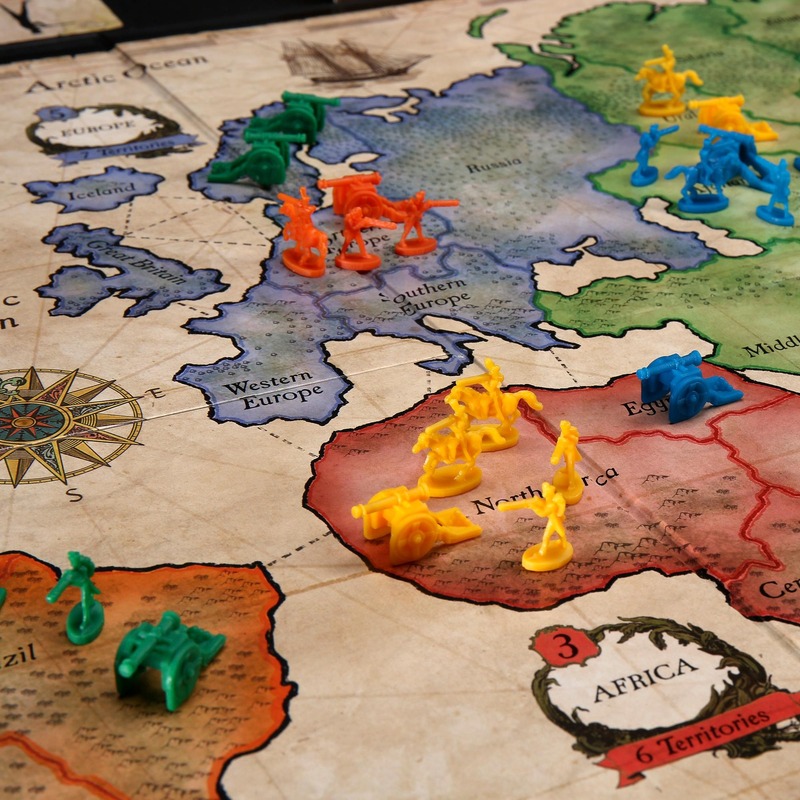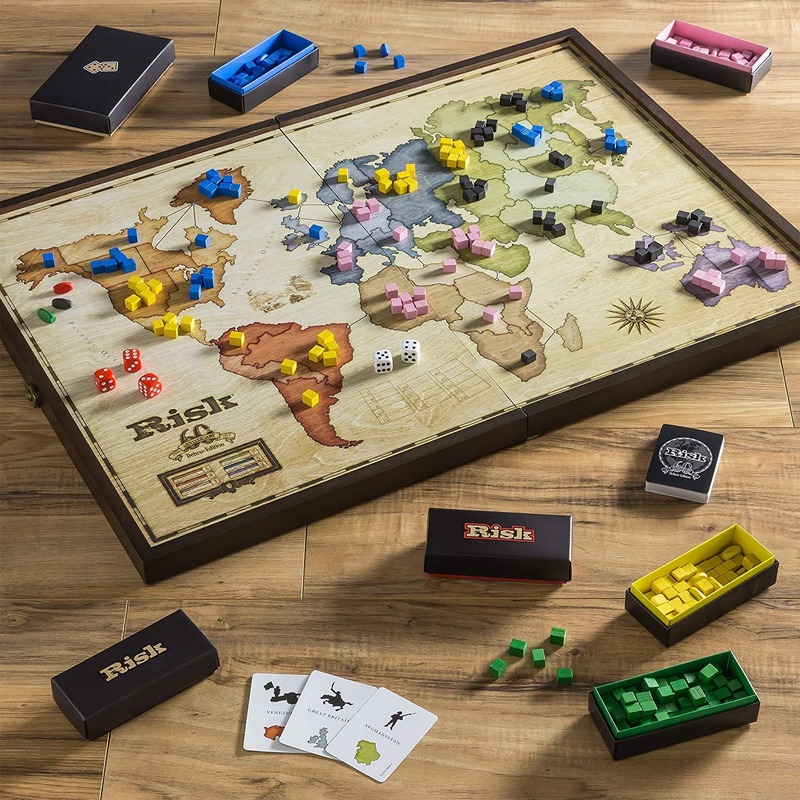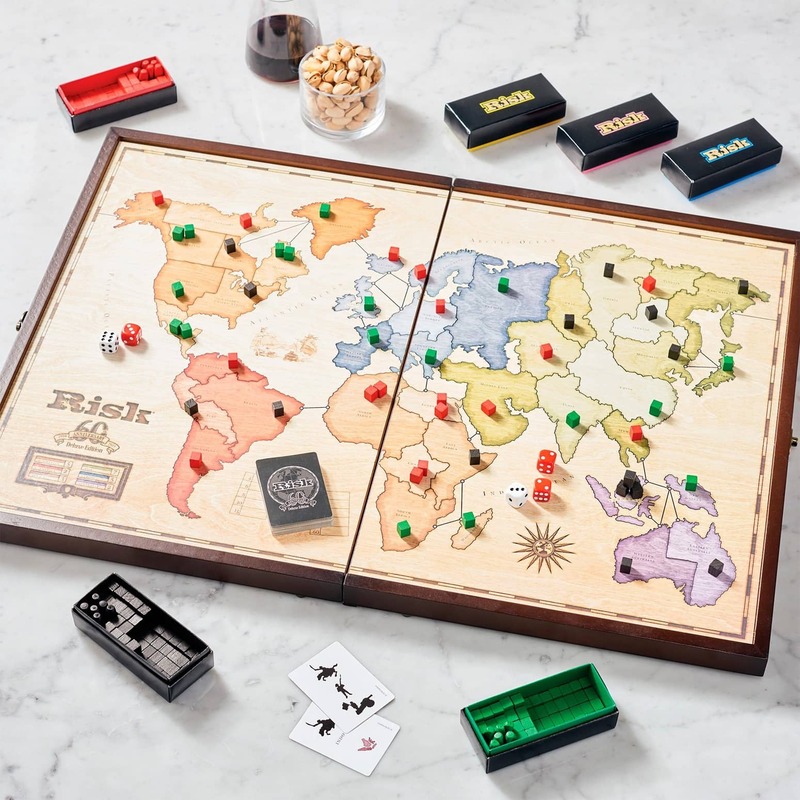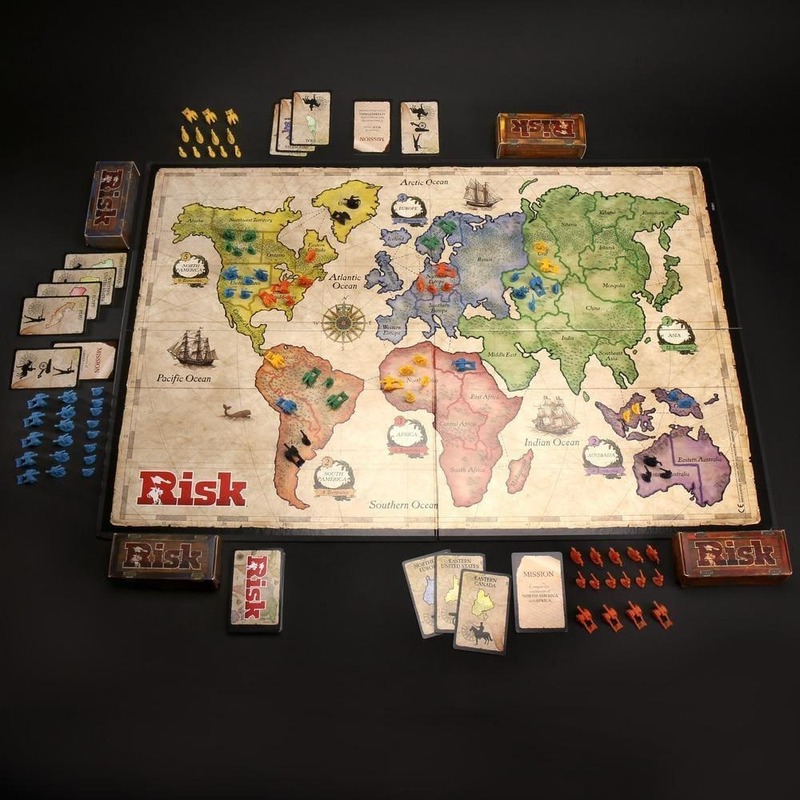Overview of Risk Board Game
Risk is a classic strategy board game of diplomacy, conflict, and conquest. Players aim to conquer territories by defeating their opponents’ armies through calculated moves and battles. The game unfolds on a world map board divided into forty-two territories across six continents. Each player starts with an allotment of armies and attempts to capture territories by rolling dice against the defending player. The ultimate goal is to occupy every territory on the board and eliminate all other players.
With the objective clear, let’s delve into the risk board game strategies. A solid understanding of the rules is the foundation of any strategy. Players must skillfully deploy their armies, choose the right battles, and fortify their positions to protect their borders. They must also balance aggression with diplomacy to form temporary alliances. Timing is critical in Risk. Knowing when to trade in cards for additional armies can provide a decisive advantage. Mastering Risk involves a blend of strategic planning, tactical execution, and the ability to adapt to changing circumstances on the board.

Essential Rules for Beginners
To excel in Risk, grasping its basic rules is vital for any beginner. Start by setting up the board and distributing territories and armies evenly among players. Each turn in Risk involves gaining and placing new armies, attacking, and fortifying positions.
Understand the setup: Place the board and shuffle the territory cards. Assign territories either randomly or through a draft process. Distribute armies equally; the number may vary based on the total players.
Learn about reinforcements: At the start of each turn, receive armies based on the number of territories you control, complete continents you occupy, and the value of trade-in cards.
Know how to attack: Choose a territory you own adjacent to an enemy territory to attack. Roll the dice to determine the outcome. More dice mean higher chances of winning, but also more armies at risk.
Tactics for defense: Defending players roll fewer dice, with ties going to the defender. Place your armies strategically to create strong border defenses.
The importance of movement: At the end of your turn, you may move armies from one territory to another, but only if there is a continuous link of territories you own. Use this to reinforce weak spots.
Card trading: Collect territory cards by conquering territories. These can be traded in for additional armies. Trade them at the right time for a significant reinforcement boost.
Remember, successful risk board game strategies hinge on how well you apply these basics. As you gain experience, you’ll learn to combine these fundamental rules with more advanced tactics to better your chances of victory.
Key Strategies for Early Game
In the early stages of Risk, strategic planning sets the groundwork for future success. Control your continent: Begin by aiming to control a small continent. This boosts your army reinforcements early on. Balance aggression with defense: Attack wisely to gain territories but keep your borders secure. Expand cautiously: Spread out too thin, and you risk losing grip on your territories. Focus on weak opponents: Target players with fewer territories for easier expansion. Form early alliances: Work with others to secure borders and plan mutual attacks. Remember, these risk board game strategies are about setting a solid foundation for the mid to late game.
Mid-Game Tactics for Maintaining Dominance
As you transition into the mid-game phase of Risk, maintaining control becomes key. Here are tactics to keep you in the lead.
Secure your borders: Fortify the borders of your territories, especially those facing aggressive opponents. A strong defense deters attacks.
Build-up armies: Accumulate large armies before launching attacks. The sight of a dominant force can intimidate others and ward off conflict.
Be unpredictable: Change up your attack strategy to keep opponents guessing. Unpredictability makes it harder for them to counter your moves.
Target weaker borders: Look for the weaker borders of your opponents to attack. It’s easier to break through and expand your reach.
Keep an army reserve: Always have some armies in reserve. They can help you react swiftly to unexpected threats or opportunities.
Monitor alliances: Watch the alliances of others closely. Be ready to support allies or pivot strategies if the power balance shifts.
Manage your cards: Use your cards for reinforcements smartly. Time your trades to maximize the impact on your army strength.
These risk board game strategies are about consolidating your power and setting the stage for an eventual victory. Stay focused and flexible to adapt to the evolving game.

Late Game Strategies for Victory
As the Risk board game enters the late game, victory hinges on precision and adaptability. Winning is not just about having a large army; it’s about strategic positioning and careful maneuvering. Here are some late game strategies that can tilt the board in your favor:
Consolidate your power: Focus on strengthening your hold on continents and key territories. This not only boosts your reinforcements but also makes it costly for opponents to attack.
Choose your battles wisely: Every move matters now. Only attack when it advances your position or weakens a rival significantly.
Maximize your reinforcements: Trade in cards at the optimal time to get the most troops possible. Timing is everything.
Keep the pressure on: Don’t give your opponents room to breathe. Maintain constant pressure on their borders to force defensive play.
Stay unpredictable: Avoid falling into a pattern. Keep changing your attack plans to confuse your rivals.
Negotiate to your advantage: Use diplomacy to create beneficial terms. Strategize with allies for joint offensives or to secure borders.
Know when to break alliances: Alliances are temporary. Betray them before they betray you, but only if it guarantees advancement.
Watch for opportunities: Be ready to seize any chance for expansion. Quick thinking can lead to a dramatic swing in territory control.
These risk board game strategies on the late game are about staying sharp and outwitting your opponents. Victory is close; play smart, and it can be yours.
Tips for Diplomacy and Alliances
In Risk, forming alliances can be as crucial as commanding armies. Here’s how you make alliances work for you:
Network early on: Start talking to players early. Build trust through initial exchanges.
Be reliable: Keep your word. A reliable partner is a valuable ally in Risk.
Choose partners wisely: Align with players whose interests match yours. Avoid unreliable allies.
Balance risks: Help allies, but not at the expense of your own objectives.
Temporary truces: Make short-term deals to tackle bigger threats. Remember, they’re not permanent.
Negotiate with caution: Make clear, simple deals. Complex agreements often fall apart.
Plan for betrayals: Alliances will break. Be ready to act when they do.
Communicate often: Keep talking to your allies. Regular updates cement alliances.
Effective diplomacy can tip the scales in your favor. Use these tips to leverage alliances and diplomacy in your risk board game strategies.
Common Mistakes to Avoid
When engaging in Risk, several common pitfalls can hinder your road to global dominance. Avoiding these mistakes is as vital as executing the right risk board game strategies.
Ignoring early continent control: Securing a continent early on is a strategic move. Overlooking this can slow your reinforcement rate.
Spreading forces too thin: Attacking too much without backup leaves you vulnerable. Keep a balanced approach between attack and defense.
Forgetting to fortify: After expanding, remember to strengthen your borders. Failing to reinforce can leave you open to counterattacks.
Neglecting card trades: Territory cards can turn the tide of the game. Don’t hold onto them too long; trade them for timely troop boosts.
Overlooking diplomacy: Alliances can make or break the game. Dismissing the power of negotiation and alliances is a strategic misstep.
Underestimating opponents: Every player has the potential to surprise you. Don’t underestimate any opponent, or it could lead to your downfall.
Lack of adaptability: Sticking rigidly to a plan is risky. Be ready to change tactics in response to the board’s dynamics.
By steering clear of these errors, you can refine your risk board game strategies and maintain an edge over your adversaries. Always stay alert and adaptable to the ever-changing landscape of the game.

Adapting Strategies Based on Opponents’ Moves
Success in Risk often hinges on how well you adapt to your opponents’ moves. Being able to shift tactics in response to the changing landscape of the game board is crucial. Here are a few adaptive risk board game strategies to consider:
Watch and learn: Observe your opponents’ strategies closely. Notice their patterns and preferences. Use this knowledge to predict their next moves and plan your counteractions.
Stay flexible: Don’t lock into one strategy. Be ready to change your approach if the game’s dynamics shift.
Capitalise on mistakes: If an opponent makes a blunder, be quick to use that to your advantage.
Adjust to alliances: When allies turn into threats, or new alliances form, rework your strategy to align with the new power structure.
Defend or Retreat: Choose between standing your ground or pulling back to a stronger position. This is key when faced with a strong attack.
Manage reinforcements: Balance your troops according to the threat level of your opponents. Place them where they can best counter upcoming attacks.
Seize the moment: When an opponent leaves a gap, take that opportunity to strike. Swift moves can change the game in your favor.
Incorporation of these adaptive risk board game strategies will enhance your ability to stay one step ahead of your competition. Remember, the objective is to maintain flexibility while keeping your ultimate goal of global domination in sight.





